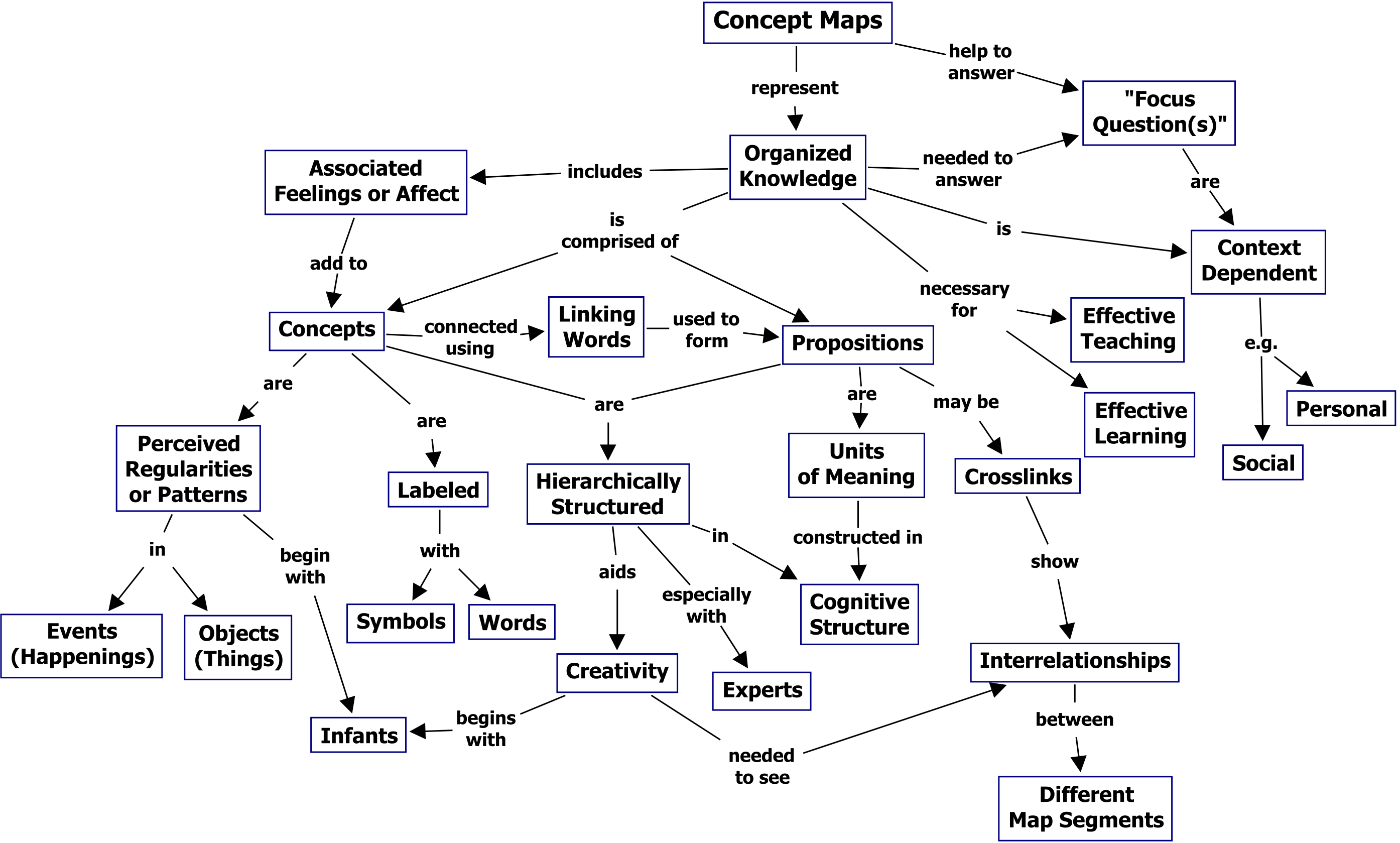Documentation:Concept Mapping Tutorial
Purpose
The purpose of this self-guided tutorial is for viewers to learn how to construct a concept map. Once you can confidently construct a concept map on a neutral topic that you likely know something about (ie. happiness), you will be able to use the same process in a controlled setting to map your current knowledge in your discipline.
This tutorial resource was developed to support concept mapping as a program evaluation process for select Collaborative Research and Training Experience (CREATE) programs. Participants are asked to map their current understanding of one of two program streams:
- atmospheric aerosols (CREATE-AAP)
- sustainable synthesis (CREATE-SusSyn)
CREATE-AAP and CREATE-SusSyn program facilitators will use the concept maps produced by participants in assessing interdisciplinary knowledge related to the study of atmospheric aerosols and sustainable synthesis, respectively. It is hoped that through this review, we will identify strengths, gaps and questions that can be used to further develop the program and curriculum.
Learning Objectives
What's in it for you?
By working through the tutorial, we hope you will have developed:
- an understanding of the key features and value of concept mapping in both supporting and demonstrating meaningful learning.
- experience and confidence in building concept maps integrating those key features
- a resource you can help develop (by sharing your own sample happiness maps) use to support learning, planning and thinking in various contexts
Materials
It is often easier to learn how to concept map by using paper rather than digital resources - to give you freedom from the constraints of the digital so you can focus on the process. However, we have included suggested resources for both approaches.
Paper
- large (easel size) sheets of paper
- sticky notes (small size)
- pencils/pens
Digital
- Bubbl.us (free, easy to use brainstorming tool )
- C-Map (free, recommended for users experienced in downloading/setting up software programs, designed specifically for concept mapping)
What is concept mapping?
Concept maps are graphic approaches for organizing and representing knowledge. They include concepts (usually represented in an enclosed box) and relationships between concepts (represented by connecting lines and linking words). Concepts connected with linking words become propositions. Propositions contain two or more concepts connected by linking words to form a meaningful statement and highlight relationships between concepts. Cross-linking links concepts across the map, often representing creative insights. Concept maps are typically arranged in a hierarchy - with the broadest, most encompassing concepts near the top and more specific concepts underneath. Concept maps may or may not be directed by a focus question such as "how do concept maps support learning?" or, a more general question like "what are concept maps?"
Meaningful learning
Joseph Novak is an educator and researcher in field of Human Cognition at the Florida Institute for Human and Machine Cognition. He and his research team at Cornell University developed the technique of concept mapping in the 1970s to support science learning among young students.
His goal to find a way to support meaningful learning – which he defined as having two requirements of learners:
- They need to know something
- They need to choose to build connections between what they know (prior learning) and new ideas (new learning) - questioning is vital to this process and concept mapping supports the task of visually representing attempts at organizing and integrating new knowledge.
In the video below, Joseph Novak describes the link between meaningful learning and concept mapping.
Key components to a concept map
- Concepts (associated with a topic and essential to understanding)
- Linking words (outlining relationships between concepts to form propositions).
- Cross-links (showing connections between disciplinary areas)
- Hierarchy (general and encompassing concepts to specifics)
- Focus question: which may or may not be used to guide the process of creating the concept map.
How do I do it?
Introduction
add a demonstration of "drawing" a concept map here.
Sample: Using Bubb.us
Click on the Center button to see the map and adjust for size using the + or - buttons.
Sample: Using C-Map

Your Turn
Create a concept map on Happiness
Using the paper method or one of the digital tools, create a concept map to answer the focus question: why is happiness important?.
Here are some resources to help you:
Once you are done, take a picture/screenshot of your map and share it here (need link to wiki page) - do we think this is a good idea?
How can it help me?
CREATE-AAP and CREATE-SusSyn program assessment
Resources
Ausubel, David P. Learning Theory and Classroom Practice. Bulletin No. 1. The Ontario Institute for Studies in Education, 1967.
Novak, J; Canas,A. The Theory Underlying Concept Maps and How to Construct and Use Them. Florida Institute for Human and Machine Cognition, Pensacola Fl, 32502
Sowa, John F. Semantic Networks
International Conference on Concept Mapping: 2008 Papers and Proceedings
References
- Chiou, C. (2008). The effect of concept mapping on students' learning achievements and interests. Innovations in Education and Teaching International, 45(4), 375-387.

- Davies, M. (2011). Concept mapping, mind mapping and argument mapping: What are the differences and do they matter? Higher Education, 62(3), 279-301.
 Permalink
Permalink